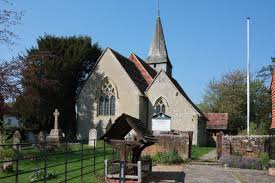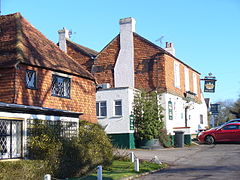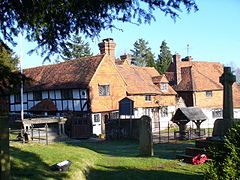Alfold is still very small and remote. The main road has encouraged little development, and neither did the Wey and Arun Junction Canal when it was operating in the village.
Its history is wrapped up in the great Wealden forest. Richard Balchin lived in the Old Glass house in Sidney Wood.
There are some beautiful buildings in the centre of Alfold and along Rosemary Lane, which runs to the right of the church and leads into Sidney Wood. This would have been the route Richard Balchin would have taken when his children were baptised in the 17th century.

The Church was first constructed in approximately 1100; further additions took place between 1200 and 1280. Fire destroyed the North Aisle in the 16th century, and it was not rebuilt then.
The Revd Richard Sparkes was Rector of Alfold from 1839 to 1879. He was born at Bramley, and was a direct descendant of the brother of Anne Sparkes who married John Balchin of Cedar House. In 1842 he is reputed to have been knocking off plaster from the walls, and discovered the three arches in a perfect state of preservation. He then had the North Aisle rebuilt, and the North Porch dismantled and rebuilt in its present position.
Another item which The Revd Richard Sparkes discovered and restored is the Communion table, buried beneath the nave at the time of the Reformation to prevent it being ‘broken, defaced or bestowed to some use’ on the orders of Archbishop Grindal in 1571. It is a single slab of polished Sussex marble containing fossils of freshwater winkles.
Richard had a large family all born in Alfold. One daughter Marian wrote a book about life in Alfold; she mentions the farm labourers in their spotless white smocks, who, when they got to church, would pull their forelocks, and the women would curtsey.
The font is believed to date from 1180 and is one of the finest and best preserved in Surrey. Churchwarden accounts of 1717 show 6/- being allowed in the rates for a replacement cover – in 1236 an order was issued that all fonts were to be securely fastened with a bar and staple to prevent baptismal water being stolen and used for magical purposes. You can still see a staple on the north side of the font.

The first Balchin to be baptised here was John, on 13th May 1666, a direct ancestor of the majority of Society members. There have been 31 Balchin baptisms here at Alfold. To this total there will be many more with Balchin blood but not the surname, such as the Luffs, Luxfords and Triggs, and my son Duncan in 1970.
The oak timbering of the church is one of its chief glories, and the roof timbers are probably 14th century. The spire and bell chamber are fine examples, supported by pillars of wood from the Wealden forest hewn by adze (pronounced ‘adds). If you really want to find something hidden, then try discerning which parts of the Church screen are made from medieval wood, and which part is closely matching Victorian. In good light the old is often slightly darker, and in poor light often feels very slightly warmer. There is a cockerel, a former weather vane, on one of the beams in the church. The spire is covered in wooden shingles which were renewed in 1989. The pews surprisingly are not Victorian but mainly of 14th and 15th century origin. The Royal Coat of Arms of George IV was restored in 1995.
The churchwarden chest bears the inscription ‘Bray Williams, Arthur Bowman Churchwardens 1687’, and even in present times can only be opened by two churchwardens together, each of whom has a key. Henry Balchin, the son of John,baptised in 1666 and direct ancestor of the Chiddingfold Balchins, was a Churchwarden in 1763, and again in 1771.
Uriah Balchin of Whites Farm was Churchwarden from 1799 to 1804. His son Henry became a churchwarden in 1819, and remained in that position until 1832. Henrys nephew, James Balchin, who ran the Three Compasses inn, just up the road from the hail by the entrance to Dunsfold Aerodrome, was also involved in parish affairs, and his signature can often be seen in the rate book. Other Balchins who had dealings with raising the rates to run the parish were John Trigg, the husband of Maria Balchin (sister of James Balchin above), and their son George Trigg. The Trigg family graves can be seen just outside the North porch.
There are 19 Balchins buried in the churchyard, plus again many more descended from the female line, for example the Triggs and Luxfords. A much worn slab of marble in the Churchyard by the war memorial is said to cover the grave of Jean Carre, one of the last of the French glassmakers, who was buried 27th May 1572. Jean Carre was responsible for introducing glassmaking from Lorraine into this country in 1567. Traces of old glass can be found in Sidney Woods. Local glassmaking died out in 1618, when timber firing for the industry was being replaced by coal.

The stocks are one of only two complete sets of stocks in Surrey. Any boy who dared to laugh in church was confined to these stocks, given a thrashing and left to meditate on his sins until the next service.
Below the churchyard was an old almshouse (destroyed in 1880) and used in the 1870s as a school.
by the late Mrs Pat Green